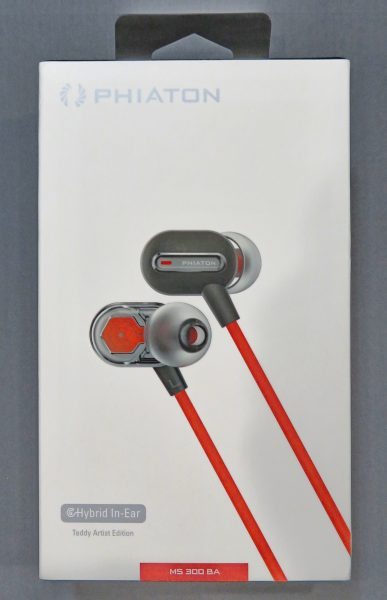
It seems that most gadgets, in general, are available at different price tiers. Speakers, quad-copters, cameras, pens, and tablets are all available from tens to thousands of dollars. The more costly versions of each will have better quality, provide more features, and perhaps provide the brand recognition that the consumer desires. The characteristic quality, features and brand (amongst other attributes) are the benefits that the added cost affords the consumer, and the ratio of cost:benefit is one way I evaluate gadgets to see if they are “worth it”. Earphones are a subcategory of speakers and they range from the $6.00 department store brand to $1225.00 JH16 Pro Custom In-Ear Monitors. The Phiaton MS 300 BA is a mid-tier, $99 MSRP, design. I found they provided an enjoyable listening experience and would be well worth the cost for the benefit they provide. Read on to see what I think!
Unboxing
The MS 300 BA comes in a box about 7 x 5″ x 2″ pictured above. Removing the box sleeve reveals a black cardboard box underneath with a top door panel. Opening the panel reveals the headphones in a plastic display above the leather carrying pouch. Included in the package is the earphones, carrying case, 4 pairs of silicone tips and a warranty card for the US and South Korea.
From the Outside…
The earphones come in two styles: a white earphone with white cord and a black earphone with red cord. I received the black and red colored unit for evaluation. The design of the earphones is sharp. The colors are reminiscent of the Apple urBeats Earphones but the style is much more reserved and in my mind, that is a good thing.
The earphones are made from plastic and include a transparent inner casing that allows the listener to see the dynamic driver housing and low pass filter wave-guide. This window is on the inside (i.e., ear facing side) of the earphone so it’s really just there for the listener’s enjoyment. I think it’s a clever way for Phiaton to demonstrate the technology that is part of these headphones. It’s also, perhaps, a nod at more expensive in-ear monitors that tend to be cured acrylic. The outside of the earphone is black plastic and includes a metal-toned banner that is inscribed with “PHIATON”. The banner also includes the filtered bass port for the dynamic driver. The strain relief for the cords is a durable rubber.
The cords are an oval shape and the surface of the cord has a corduroy-like pattern. Phiaton markets these as textured tangle-free cables that minimize cable tangling and minimize cable touch noise. I can’t say that the cord is tangle proof, but when I needed to sort out a mess of the cables the corduroy pattern seemed to limit the surface available for the cord to grip itself.
The mic and function button is located on the left earphone cord about 7 inches down. I’m not sure if mounting the mic on the left is typical of android phone manufactures but it is definitely not the way Apple rolls. It just so happens that I’m left handed so this design suits me rather well. There is still a downside, however. The opposite side of the mic only has one button. You can’t adjust the volume with these earphones. I’d say this would be a deal-breaker for wireless earphones, but since this is a wired set you’re always about 44 inches from your music source.
The button cover is a completely separate piece of plastic and not just a flexible extension of the microphone casing. Therefore the button jiggles a little bit if you lightly touch it. The button does function for all of the iPhone capability: 1 press = play/pause/answer/hang-up; 2 presses = skip to next song; 3 presses = skip to start of song/skip to previous song; long press = Siri. If only Siri could change the volume…
The cords come together in a junction that is center mounted about 15 inches down from the earphone. The outside of the shiny black plastic has PHIATON written in silver letters.
The 1/8 inch audio jack is a right angle design with a hefty strain relief and the Phiaton logo on the back. the strain relief is about an 1/8 inch from the end of the audio plug so this should work for most cases but may not be compatible with Lifeproof or others like it without an adapter.
When you’re not listening to your earphones you can store them in the leather carrying case. It has a felt interior and a magnetic clasp.
On the inside…
So what exactly is Phiaton’s Hybrid Dual Driver technology and Low-Frequency Pass Filters (LPF) and how do they combine to deliver exceptional acoustics? Each of the earphones have two speakers in them, similar to what you may find in a shelf or floor system. The two speakers are a dynamic driver and a balanced armature. The combination of the dynamic driver and the balanced armature provides an improved frequency response compared to systems which include only a dynamic driver. The dynamic driver is what most people associate with a speaker: a wire coil attached to a large diaphragm that moves the air when electrical current is passed through the coil. These speakers are best for producing low to mid range frequencies. The other type of speaker used is a balanced armature. These speakers work similarly to a middle ear in reverse. A small armature is mounted in a magnetic field and pivots when a current is applied to a coil surrounding it. The armature is coupled to a membrane and the small movement of the armature is amplified by the membrane. The movements of this type of speaker are very precise but it doesn’t have the capability of moving lots of air, so this speaker is best for mid to high frequencies.
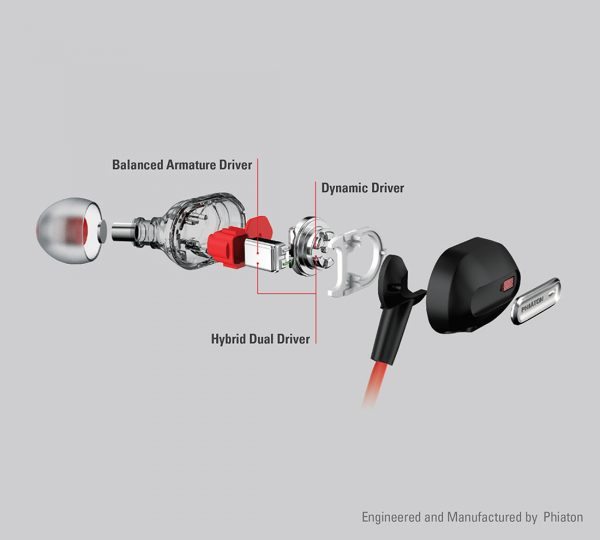
From the exploded view above it doesn’t look like there are electronic components that comprise the low pass filter so I can only assume that it is limited to the acoustic waveguide on top of the dynamic driver. There is no high pass filter, except for the fact that the low frequency response on the balanced armature is very low. The technical specifications of the system are: Impedance: 16 Ω; Sensitivity: 105 dB/Mw; Frequency Response: 10 Hz ~ 27 kHz; Max. Input Power: 40 mW. In addition, the cables conductors are oxygen-free 99.99% pure copper to help ensure a clean connection and minimal audio distortion.
The Fit
The earphones are provided with 4 silicone tips. From the picture below it appears that the post is about 3/16 inch, (or about 4.8 mm).
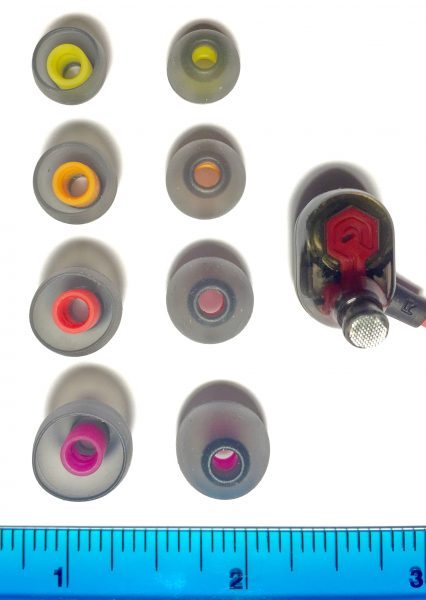
It is important to ensure that the correct sleeves are used to get the best fit. Poor low-frequency response is indicative of a poor fit. Go here and listen to the audio files to test the response of the earphones. I can’t really elaborate on the fit except to say that they fit me. I have a couple of pics to show what they look like in my ears.
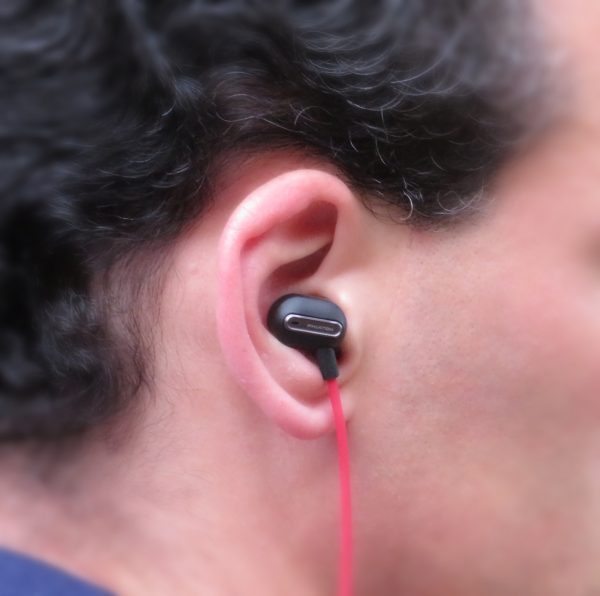
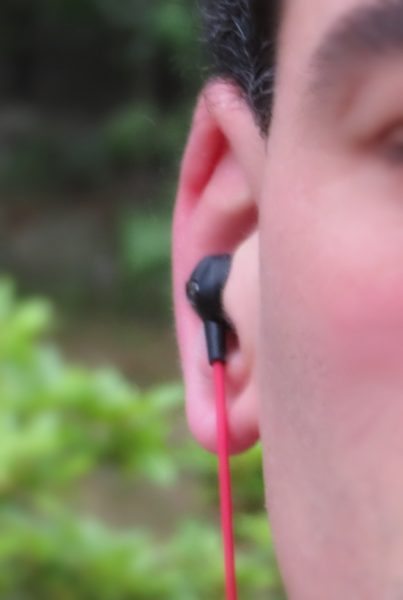
The experience
I’ve listened to a bunch of music with these and I’m impressed with the results. I have a few samples to demonstrate. Most of these can be heard on iTunes or Amazon as samples.
The first track is Cluster One from Pink Floyd’s The Division Bell. It’s sort of an odd choice because it’s not melodic at all, it’s a sample of ionic disturbances in the earth’s magnetosphere, but there are some very high and very low frequencies going on here. A lesser pair of earphones will entirely miss the high frequencies and some of the very low-frequency registers.
The next track is 1–Introduction and Allegro from Organ Sensation, Felix Hell from reference recordings. This is an interesting piece to gauge the precision of the earphones to reproduce distinct tones coming from individual pipes of the organ and also to reproduce the full frequency range of each pipe. I’m not sure what stops Hell is using on this recording, but the theoretical low end of a 32′ is about 16 Hz.
Ok, this is sort of esoteric stuff. How about mainstream? Still D.R.E. [feat. Snoop Dogg] [Explicit] from Dr. Dre’s 2001 is a great track for bass and these earphones don’t disappoint. On lesser earphones the bass thumps sound muddy and just like a bass frequency harmonic. With the MS-300-BA the bass sounds like a bass drum; the sound has a lot more character than just a tone.
Rap not your thing? How about Jazz? Suite Escapism “In Between” is a fantastic recording and there are all sorts of musical nuances that the listener can appreciate with these headphones. You get a great sense of presence from these headphones, like your at a jazz concert. Jungleland by Bruce Springsteen is another epic track and these earphones transmit the fanfare of this song and its big sound yet still pick up the subtlety of Springsteen’s breath towards the beginning of the song.
The microphone provides good pickup and isolation of my voice as determined by the recipients of a number of phone calls.
Summary
If you’re in the market for a solid mid-tier set of earphones then I recommend the Phiaton MS-300-BA. Their technical capabilities will be well appreciated. I definitely feel they’re worth it.
Source: The sample for this review was provided by Phiaton. Please visit their site for more information and Amazon to check prices / order.

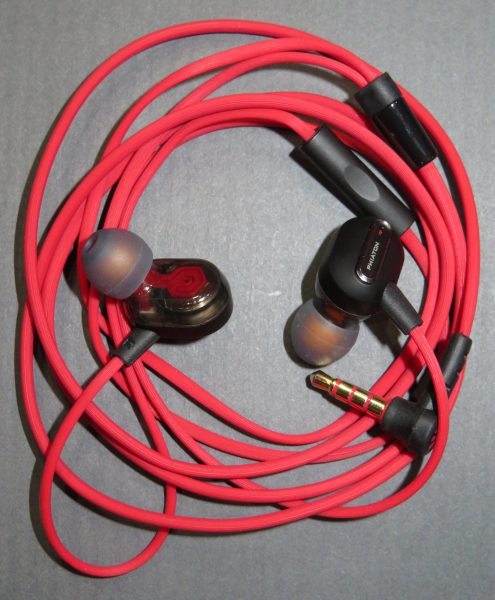
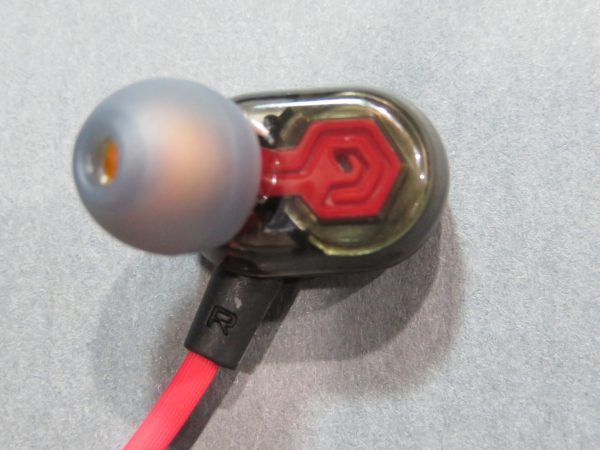
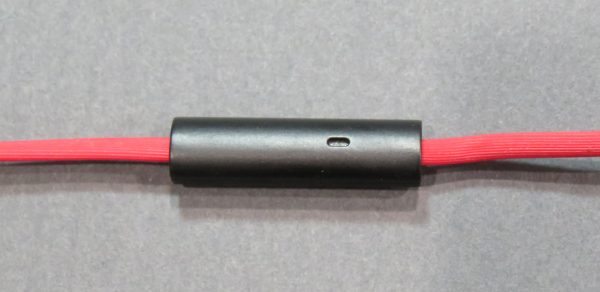

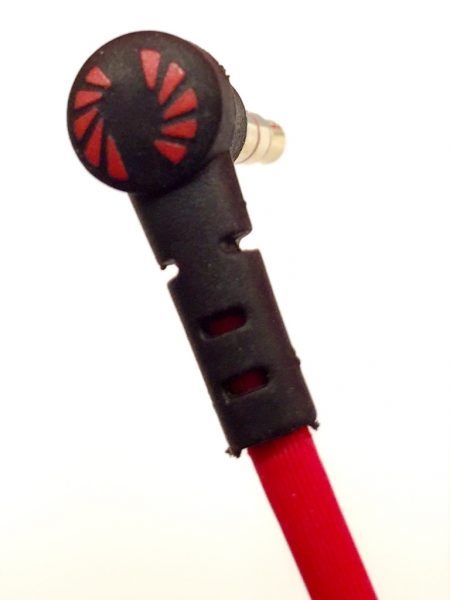
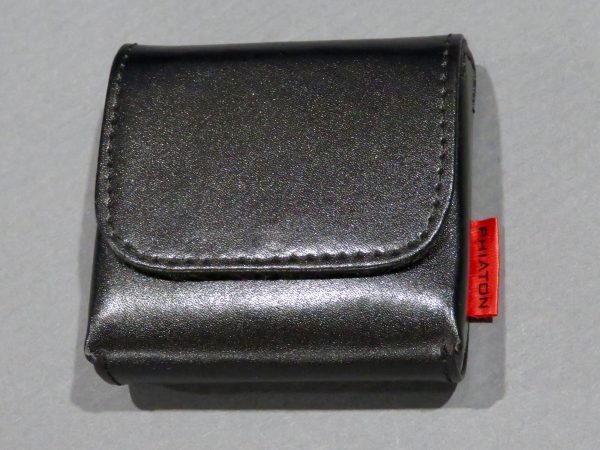


Gadgeteer Comment Policy - Please read before commenting
Hey, i don’t get the experience section… you seem to just give a bunch of songs and describe them without explaining how well the earphones do in replicating the music.
The hardware and sound engineering to produce frequency response curves or equalization curves of earphones is very expensive and time consuming, and the result – a squiggly line – has a lot less meaning than explaining the experience of listening with the headphones on. Therefore we generally tend towards the later option in our reviews. If you have another suggestion for communicating earphone performance then please let us know.
The problem with explaining your experience when listening to a pair of headphones, is that it is 100% a personal experience. Nobody else in the world will have the same experience. Besides, personal experiences and feelings change on a day-to-day basis.
It doesn’t tell anybody anything about how they would experience the headphones. Or how they would sound to them. It takes time and dedication to learn to read the “squiggly line”, but to learn your personal sound profile preference, how various earphones fit in your ear, and how you write and use terminology to describe sound, etc, is roughly a thousand times harder.
Comparisons to models that the reader has experience in (or might/should also be considering as an alternative to the earphone being reviewed), would be extremely valuable, and a shortcut to deliver the most information possible about the sound of an earphone, in the shortest amount of time and the least effort from all parties.
“The midrange sounds like Hifiman RE-400, except a bit warmer in the lower mids.”
That would tell everybody who has tried the RE-400 how they would experience the earphone in question, with good detail. If they felt the RE-400 lacking in midrange warmth, they’ll now know that the earphone being reviewed would likely suit their personal preferences very well.